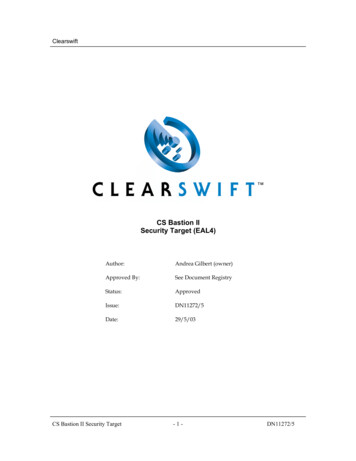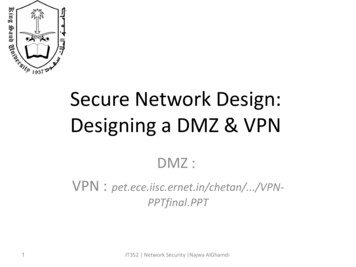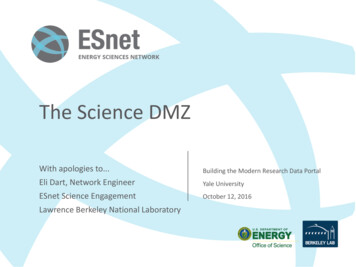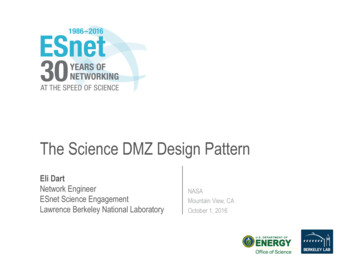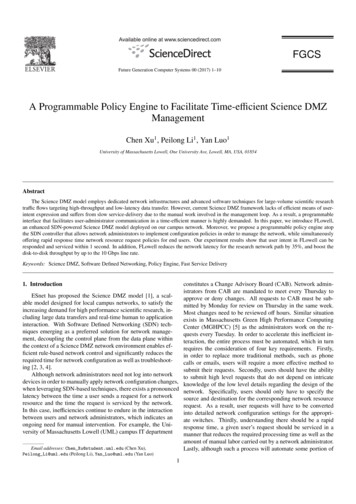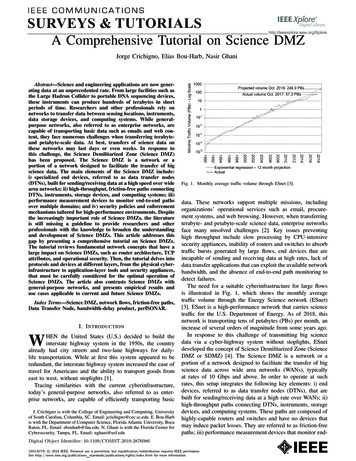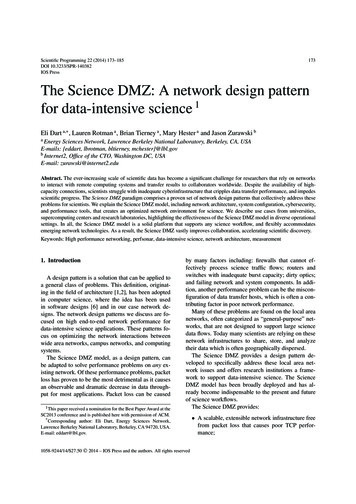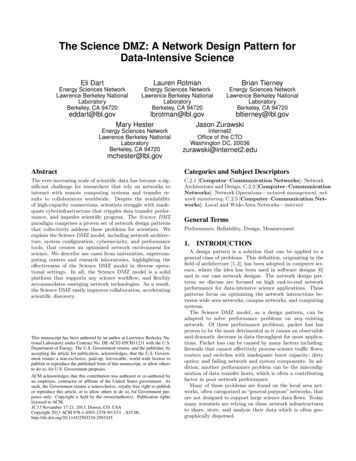
Transcription
The Science DMZ: A Network Design Pattern forData-Intensive ScienceEli DartLauren RotmanBrian TierneyEnergy Sciences NetworkLawrence Berkeley NationalLaboratoryBerkeley, CA 94720Energy Sciences NetworkLawrence Berkeley NationalLaboratoryBerkeley, CA 94720Energy Sciences NetworkLawrence Berkeley NationalLaboratoryBerkeley, CA ovMary HesterJason ZurawskiEnergy Sciences NetworkLawrence Berkeley NationalLaboratoryBerkeley, CA 94720mchester@lbl.govInternet2Office of the CTOWashington DC, 20036zurawski@internet2.eduAbstractCategories and Subject DescriptorsThe ever-increasing scale of scientific data has become a significant challenge for researchers that rely on networks tointeract with remote computing systems and transfer results to collaborators worldwide. Despite the availabilityof high-capacity connections, scientists struggle with inadequate cyberinfrastructure that cripples data transfer performance, and impedes scientific progress. The Science DMZparadigm comprises a proven set of network design patternsthat collectively address these problems for scientists. Weexplain the Science DMZ model, including network architecture, system configuration, cybersecurity, and performancetools, that creates an optimized network environment forscience. We describe use cases from universities, supercomputing centers and research laboratories, highlighting theeffectiveness of the Science DMZ model in diverse operational settings. In all, the Science DMZ model is a solidplatform that supports any science workflow, and flexiblyaccommodates emerging network technologies. As a result,the Science DMZ vastly improves collaboration, acceleratingscientific discovery.C.2.1 [Computer–Communication Networks]: NetworkArchitecture and Design; C.2.3 [Computer–CommunicationNetworks]: Network Operations—network management, network monitoring; C.2.5 [Computer–Communication Networks]: Local and Wide-Area Networks—internetThis manuscript has been authored by an author at Lawrence Berkeley National Laboratory under Contract No. DE-AC02-05CH11231 with the U.S.Department of Energy. The U.S. Government retains, and the publisher, byaccepting the article for publication, acknowledges, that the U.S. Government retains a non-exclusive, paid-up, irrevocable, world-wide license topublish or reproduce the published form of this manuscript, or allow othersto do so, for U.S. Government purposes.ACM acknowledges that this contribution was authored or co-authored byan employee, contractor or affiliate of the United States government. Assuch, the Government retains a nonexclusive, royalty-free right to publishor reproduce this article, or to allow others to do so, for Government purposes only. Copyright is held by the owner/author(s). Publication rightslicensed to ACM.SC13 November 17-21, 2013, Denver, CO, USACopyright 2013 ACM 978-1-4503-2378-9/13/11 . eral TermsPerformance, Reliability, Design, Measurement1.INTRODUCTIONA design pattern is a solution that can be applied to ageneral class of problems. This definition, originating in thefield of architecture [1,2], has been adopted in computer science, where the idea has been used in software designs [6]and in our case network designs. The network design patterns we discuss are focused on high end-to-end networkperformance for data-intensive science applications. Thesepatterns focus on optimizing the network interactions between wide area networks, campus networks, and computingsystems.The Science DMZ model, as a design pattern, can beadapted to solve performance problems on any existingnetwork. Of these performance problems, packet loss hasproven to be the most detrimental as it causes an observableand dramatic decrease in data throughput for most applications. Packet loss can be caused by many factors including:firewalls that cannot effectively process science traffic flows;routers and switches with inadequate burst capacity; dirtyoptics; and failing network and system components. In addition, another performance problem can be the misconfiguration of data transfer hosts, which is often a contributingfactor in poor network performance.Many of these problems are found on the local area networks, often categorized as “general-purpose” networks, thatare not designed to support large science data flows. Todaymany scientists are relying on these network infrastructuresto share, store, and analyze their data which is often geographically dispersed.
The Science DMZ provides a design pattern developed tospecifically address these local area network issues and offersresearch institutions a framework to support data-intensivescience. The Science DMZ model has been broadly deployedand has already become indispensable to the present andfuture of science workflows.The Science DMZ provides: A scalable, extensible network infrastructure free frompacket loss that causes poor TCP performance; Appropriate usage policies so that high-performanceapplications are not hampered by unnecessary constraints; An effective “on-ramp” for local resources to accesswide area network services; and Mechanisms for testing and measuring, thereby ensuring consistent performance.This paper will discuss the Science DMZ from its development to its role in future technologies. First, Section 2will discuss the Science DMZ’s original development in addressing the performance of TCP-based applications. Second, Section 3 enumerates the components of the ScienceDMZ model and how each component adds to the overallparadigm. Next, Sections 4 and 5 offer some sample illustrations of networks that vary in size and purpose. Following,Section 6 will discuss some examples of Science DMZ implementations from the R&E community. And lastly, Section 7highlights some future technological advancements that willenhance the applicability of the Science DMZ design.2.MOTIVATIONWhen developing the Science DMZ, several key principlesprovided the foundation to its design. First, these designpatterns are optimized for science. This means the components of the system—including all the equipment, softwareand associated services—are configured specifically to support data-intensive science. Second, the model is designedto be scalable in its ability to serve institutions rangingfrom large experimental facilities to supercomputing sitesto multi-disciplinary research universities to individual research groups or scientists. The model also scales to serve agrowing number of users at those facilities with an increasing and varying amount of data over time. Lastly, the Science DMZ model was created with future innovation in mindby providing the flexibility to incorporate emerging networkservices. For instance, advances in virtual circuit services,100 Gigabit Ethernet, and the emergence of software-definednetworking present new and exciting opportunities to improve scientific productivity. In this section, we will mostlydiscuss the first principle since it is the driving mission forthe Science DMZ model.The first principle of the model is to optimize the networkfor science. To do this, there are two entities or areas of thenetwork that should be considered: the wide area networkand the local area networks. The wide area networks (orWANs) are often already optimized and can accommodatelarge data flows up to 100Gbps. However, the local areanetworks are still a choke point for these large data flows.Local area networks are usually general-purpose networksthat support multiple missions, the first of which is to support the organization’s business operations including email,procurement systems, web browsing, and so forth. Second,these general networks must also be built with security thatprotects financial and personnel data. Meanwhile, these networks are also used for research as scientists depend on thisinfrastructure to share, store, and analyze data from manydifferent sources. As scientists attempt to run their applications over these general-purpose networks, the result isoften poor performance, and with the increase of data setcomplexity and size, scientists often wait hours, days, orweeks for their data to arrive.Since many aspects of general-purpose networks are difficult or impossible to change in the ways necessary to improve their performance, the network architecture must beadapted to accommodate the needs of science applicationswithout affecting mission critical business and security operations. Some of these aspects that are difficult to changemight include the size of the memory buffers for individualinterfaces; mixed traffic patterns between mail and web traffic that would include science data; and emphasis on availability vs. performance and what can be counted on overtime for network availability.The Science DMZ model has already been implemented atvarious institutions to upgrade these general-purpose, institutional networks. The National Science Foundation (NSF)recognized the Science DMZ as a proven operational bestpractice for university campuses supporting data-intensivescience and specifically identified this model as eligible forfunding through the Campus Cyberinfrastructure–NetworkInfrastructure and Engineering Program (CC-NIE).1 Thisprogram was created in 2012 and has since been responsible for implementing approximately 20 Science DMZs atdifferent locations—thereby serving the needs of the sciencecommunity. Another NSF solicitation was released in 2013and awards to fund a similar number of new Science DMZ’sare expected.2.1TCP PerformanceThe Transmission Control Protocol (TCP) [15] of theTCP/IP protocol suite is the primary transport protocolused for the reliable transfer of data between applications.TCP is used for email, web browsing, and similar applications. Most science applications are also built on TCP, so itis important that the networks are able to work with theseapplications (and TCP) to optimize the network for science.TCP is robust in many respects—in particular it has sophisticated capabilities for providing reliable data deliveryin the face of packet loss, network outages, and networkcongestion. However, the very mechanisms that make TCPso reliable also make it perform poorly when network conditions are not ideal. In particular, TCP interprets packet lossas network congestion, and reduces its sending rate whenloss is detected. In practice, even a tiny amount of packetloss is enough to dramatically reduce TCP performance, andthus increase the overall data transfer time. When appliedto large tasks, this can mean the difference between a scientist completing a transfer in days rather than hours orminutes. Therefore, networks that support data-intensivescience must provide TCP-based applications with loss-freeservice if TCP-based applications are to perform well in thegeneral case.As an example of TCP’s sensitivity, consider the follow1NSF’s CC-NIE Program: l.
Figure 1: Graph shows the TCP throughput vs. round-trip time (latency) with packet loss between 10Gbps connected hosts, as predictedby the Mathis Equation. The topmost line (shown in purple) shows the throughput for TCP in a loss-free environment.ing case. In 2012, Department of Energy’s (DOE) EnergySciences Network (ESnet) had a failing 10 Gbps router linecard that was dropping 1 out of 22, 000 packets, or 0.0046%of all traffic. Assuming the line card was working at peakefficiency, or 812, 744 regular sized frames per second,2 37packets were lost each second due to the loss rate. While thisonly resulted in an overall drop of throughput of 450 Kbps(on the device itself), it reduced the end-to-end TCP performance far more dramatically as demonstrated in Figure 1.This packet loss was not being reported by the router’s internal error monitoring, and was only noticed using the owampactive packet loss monitoring tool, which is part of the perfSONAR Toolkit 3 .Because TCP interprets the loss as network congestion,it reacts by rapidly reducing the overall sending rate. Thesending rate then slowly recovers due to the dynamic behavior of the control algorithms. Network performance can benegatively impacted at any point during the data transferdue to changing conditions in the network. This problem isexacerbated as the latency increases between communicatinghosts. This is often the case when research collaborationssharing data are geographically distributed. In addition,feedback regarding the degraded performance takes longerto propagate between the communicating hosts.The relationship between latency, data loss, and networkcapability was described by Mathis et al. as a mechanismto predict overall throughput [12]. The “Mathis Equation”states that maximum TCP throughput is at most:1maximum segment size .round-trip timepacket loss rate(1)Figure 1 shows the theoretical rate predicted by the MathisEquation, along with the measured rate for both TCP-Renoand TCP-Hamilton across ESnet. These tests are between10Gbps connected hosts configured to use 9KByte (“JumboFrame”) Maximum Transmission Units (MTUs).This example is indicative of the current operational reality in science networks. TCP is used for the vast majorityof high-performance science applications. Since TCP is sosensitive to loss, a science network must provide TCP witha loss-free environment, end-to-end. This requirement, inturn, drives a set of design decisions that are key compo2Performance telligence/network performancemetrics.html.3perfSONAR Toolkit: http://psps.perfsonar.netnents of the Science DMZ model.3.THE SCIENCE DMZ DESIGN PATTERNThe overall design pattern or paradigm of the ScienceDMZ is comprised of four sub-patterns. Each of these subpatterns offers repeatable solutions for four different areas ofconcern: proper location (in network terms) of devices andconnections; dedicated systems; performance measurement;and appropriate security policies. These four sub-patternswill be discussed in the following subsections.3.1Proper Location to Reduce ComplexityThe physical location of the Science DMZ (or “locationdesign pattern”) is important to consider during the deployment process. The Science DMZ is typically deployed at ornear the network perimeter of the institution. The reasonfor this is that it is important to involve as few network devices as reasonably possible in the data path between theexperiment at a science facility, the Science DMZ, and theWAN.Network communication between applications running ontwo hosts traverses, by definition, the hosts themselves andthe entire network infrastructure between the hosts. Giventhe sensitivity of TCP to packet loss (as discussed in Section 2.1), it is important to ensure that all the componentsof the network path between the hosts are functioning properly and configured correctly. Wide area science networksare typically engineered to perform well for science applications, and in fact the Science DMZ model assumes thatthe wide area network is doing its job. However, the localnetwork is often complex, and burdened with the compromises inherent in supporting multiple competing missions.The location design pattern accomplishes two things. Thefirst is separation from the rest of the general network, andthe second is reduced complexity.There are several reasons to separate the highperformance science traffic from the rest of the network. Thesupport of high-performance applications can involve the deployment of highly capable equipment that would be tooexpensive to use throughout the general-purpose networkbut that has necessary features such as high-performancefiltering capabilities, sufficient buffering for burst capacity,and the ability to accurately account for packets that traverse the device. In some cases, the configuration of the network devices must be changed to support high-speed dataflows—an example might be conflict between quality of service settings for the support of enterprise telephony and
the burst capacity necessary to support long-distance highperformance data flows. In addition, the location patternmakes the application of the appropriate security patternsignificantly easier (see Section 3.4).The location design pattern can also significantly reducethe complexity of the portion of the network used for science applications. Troubleshooting is time-consuming, andthere is a large difference in operational cost and time-toresolution between verifying the correct operation of a smallnumber of routers and switches and tracing the science flowthrough a large number of network devices in the generalpurpose network of a college campus. For this reason, theScience DMZ is typically located as close to the networkperimeter as possible, i.e. close to or directly connected tothe border router that connects the research institution’snetwork to the wide area science network.3.2Dedicated Systems: The Data TransferNode (DTN)Systems used for wide area science data transfers performfar better if they are purpose-built for and dedicated to thisfunction. These systems, which we call data transfer nodes(DTNs), are typically PC-based Linux servers constructedwith high quality components and configured specifically forwide area data transfer. The DTN also has access to storage resources, whether it is a local high-speed disk subsystem, a connection to a local storage infrastructure, such as astorage area network (SAN), or the direct mount of a highspeed parallel file system such as Lustre4 or GPFS.5 TheDTN runs the software tools used for high-speed data transfer to remote systems. Some typical software packages include GridFTP6 [3] and its service-oriented front-end GlobusOnline7 [4], discipline-specific tools such as XRootD,8 andversions of default toolsets such as SSH/SCP with highperformance patches9 applied.DTNs are widely applicable in diverse science environments. For example, DTNs are deployed to support Beamline 8.3.2 at Berkeley Lab’s Advanced Light Source,10 andas a means of transferring data to and from a departmental cluster. On a larger scale, sets of DTNs are deployed atsupercomputer centers (for example at the DOE’s ArgonneLeadership Computing Facility,11 the National Energy Research Scientific Computing Center,12 and Oak Ridge Leadership Computing Facility13 ) to facilitate high-performancetransfer of data both within the centers and to remote sites.At even larger scales, large clusters of DTNs provide dataservice to the Large Hadron Collider (LHC)14 collaborations. The Tier-115 centers deploy large numbers of DTNs4Lustre. http//www.lustre.org/.GPFS. . s Online. https://www.globusonline.org/8XRootD. http://xrootd.slac.stanford.edu/.9HPN-SSH. LBNL ALS. http://www-als.lbl.gov.11ALCF. https://www.alcf.anl.gov.12NERSC. http://www.nersc.gov.13OLCF. http://www.olcf.ornl.gov/.14LHC. http://lhc.web.cern.ch/lhc/.15US/LHC. http://www.uslhc.us/The US and the LHC/Computing.5to support thousands of scientists. These are systems dedicated to the task of data transfers so that they providereliable, high-performance service to science applications.16DTNs typically have high-speed network interfaces, butthe key is to match the DTN to the capabilities of the widearea network infrastructure. For example, if the networkconnection from the site to the WAN is 1 Gigabit Ethernet,a 10 Gigabit Ethernet interface on the DTN may be counterproductive. The reason for this is that a high-performanceDTN can overwhelm the slower wide area link causing packetloss.The set of applications that run on a DTN is typicallylimited to parallel data transfer applications like GridFTPor FDT.17 In particular, user-agent applications associatedwith general-purpose computing and business productivity(e.g., email clients, document editors, media players) are notinstalled. This is for two reasons. First, the dedication of theDTN to data transfer applications produces more consistentbehavior and avoids engineering trade-offs that might bepart of supporting a larger application set. Second, datatransfer applications are relatively simple from a networksecurity perspective, and this makes the appropriate securitypolicy easier to apply (see Section 3.4).Because the design and tuning of a DTN can be timeconsuming for small research groups, ESnet has a DTN Tuning guide18 and a Reference DTN Implementation guide.19The typical engineering trade-offs between cost, redundancy,performance, and so on. apply when deciding on what hardware to use for a DTN. In general, it is recommended thatDTNs be procured and deployed such that they can be expanded to meet future storage requirements.3.3Performance MonitoringPerformance monitoring is critical to the discovery andelimination of so-called “soft failures” in the network. Softfailures are problems that do not cause a complete failurethat prevents data from flowing (like a fiber cut), but causespoor performance. Examples of soft failures include packetloss due to failing components; dirty fiber optics; routersforwarding packets using the management CPU rather thanthe high-performance forwarding hardware; and inadequatehardware configuration. Soft failures often go undetectedfor many months or longer, since most network management and error reporting systems are optimized for reporting“hard failures”, such as loss of a link or device. Also, manyscientists do not know what level of performance to expect,and so they do not know when to alert knowledgeable staffabout a potential problem.A perfSONAR host [16] helps with fault diagnosis on theScience DMZ. It offers end-to-end testing with collaborating sites that have perfSONAR tools installed, which allowsfor multi-domain troubleshooting. perfSONAR is a networkmonitoring software suite designed to conduct both activeand passive network measurements, convert these to a standard format, and then publish the data so it is publiclyaccessible. The perfSONAR host can run continuous checks16LHCOPN. http://lhcopn.web.cern.ch/lhcopn/.FTD. http://monalisa.cern.ch/FDT/18DTN Tuning. Reference DTN. node-reference-implementation/.17
Border RouterEnterprise BorderRouter/FirewallWAN10G10GE10GESite / Campusaccess to ScienceDMZ resourcesClean,High-bandwidthWAN pathperfSONAR10GESite / CampusLANScience DMZSwitch/Router10GEperfSONARPer-servicesecurity policycontrol pointsHigh performanceData Transfer Nodewith high-speed storageHigh Latency WAN PathLow Latency LAN PathFigure 2: Regular perfSONAR monitoring of the ESnet infrastructure. The color scales denote the “degree” of throughput forthe data path. Each square is halved to show the traffic rate ineach direction between test hosts.Figure 3: Example of the simple Science DMZ. Shows the datapath through the border router and to the DTN (shown in green).The campus site access to the Science DMZ resources is shown inred.for latency changes and packet loss using OWAMP,20 as wellas periodic “throughput” tests (a measure of available network bandwidth) using BWCTL.21 If a problem arises thatrequires a network engineer to troubleshoot the routing andswitching infrastructure, the tools necessary to work theproblem are already deployed—they need not be installedbefore troubleshooting can begin.By deploying a perfSONAR host as part of the ScienceDMZ architecture, regular active network testing can beused to alert network administers when packet loss rates increase, or throughput rates decrease. This is demonstratedby “dashboard” applications, as seen in Figure 2. Timelyalerts and effective troubleshooting tools significantly reducethe time and effort required to isolate the problem and resolve it. This makes high performance the norm for scienceinfrastructure, and provides significant productivity advantages for data-intensive science experiments.ing the Science DMZ in a separate location in the networktopology, the traffic in the Science DMZ is separated fromthe traffic on the rest of the network (i.e., email, etc.), andsecurity policy and tools can be applied specifically to thescience-only traffic on the Science DMZ. The use of dedicated systems limits the application set deployed on theScience DMZ, and also reduces the attack surface.A comprehensive network security capability uses manytools and technologies, including network and host intrusiondetection systems, firewall appliances, flow analysis tools,host-based firewalls, router access control lists (ACLs), andother tools as needed. Appropriate security policies and enforcement mechanisms are designed based on the risk levelsassociated with high-performance science environments andbuilt using components that scale to the data rates requiredwithout causing performance problems. Security for a dataintensive science environment can be tailored for the datatransfer systems on the Science DMZ.Science DMZ resources are designed to interact with external systems, and are isolated from (or have carefully managed access to) internal systems. This means the securitypolicy for the Science DMZ can be tailored for this purpose.Users at the local site who access resources on their local Science DMZ through the lab or campus perimeter firewall willtypically get reasonable performance, since the latency between the local users and the local Science DMZ is low (evenif the firewall causes some loss), TCP can recover quickly.3.4Appropriate SecurityNetwork and computer security are of critical importancefor many organizations. Science infrastructures are no different than any other information infrastructure. They mustbe secured and defended. The National Institute for Standards and Technology (NIST) framework for security usesthe CIA concepts—Confidentiality, Integrity, and Availability.22 Data-intensive science adds another dimension—performance. If the science applications cannot achieve adequate performance, the science mission of the infrastructurehas failed. Many of the tools in the traditional networksecurity toolbox do not perform well enough for use in highperformance science environments. Rather than compromise security or compromise performance, the Science DMZmodel addresses security using a multi-pronged approach.The appropriate security pattern is heavily dependent onthe location and the dedicated systems patterns. By ions/PubsFIPS.html.4.SAMPLE DESIGNSAs a network design paradigm, the individual patterns ofthe Science DMZ can be combined in many different ways.The following examples of the overall Science DMZ modelare presented as illustrations of the concepts using notionalnetwork diagrams of varying size and functionality.4.1Simple Science DMZA simple Science DMZ has several essential components.These include dedicated access to high-performance widearea networks, high-performance network equipment, DTNs,and monitoring infrastructure provided by perfSONAR.
Border NARVirtualCircuitperfSONARVCProvider t endswitchFront witch/RouterBorderRoutersData TransferClusterData ServiceSwitch PlaneData TransferNodesSupercomputerperfSONARParallel FilesystemFigure 4: Example supercomputer center built as a Science DMZ.These components are organized in an abstract diagram withdata paths in Figure 3.The DTN is connected directly to a high-performanceScience DMZ switch or router, which is attached to theborder router. By attaching the Science DMZ to the borderrouter, it is much easier to guarantee a packet loss free pathto the DTN, and to create virtual circuits that extend allthe way to the end host. The DTN’s job is to efficiently andeffectively move science data between the local environmentand remote sites and facilities. The security policy enforcement for the DTN is done using access control lists (ACLs)on the Science DMZ switch or router, not on a separatefirewall. The ability to create a virtual circuit all the way tothe host also provides an additional layer of security. Thisdesign is suitable for the deployment of DTNs that serveindividual research projects or to support one particularscience application. An example use case of the simpleScience DMZ is discussed in Sections 6.1 and 6.2.4.2Supercomputer Center NetworkThe notional diagram shown in Figure 4 illustrates a simplified supercomputer center network. While this may notlook much like the simple Science DMZ diagram in Figure 3,the same principles are used in its design.Many supercomputer centers already use the ScienceDMZ model. Their networks are built to handle high-ratedata flows without packet loss, and designed to allow easytroubleshooting and fault isolation. Test and measurementsystems are integrated into the infrastructure from thebeginning, so that problems can be located and resolvedquickly, regardless of whether the local infrastructure isat fault. Note also that access to the parallel filesystemby wide area data transfers is via data transfer nodes thatare dedicated to wide area data transfer tasks. Whendata sets are transferred to the DTN and written to theparallel filesystem, the data sets are immediately availableon the supercomputer resources without the need fordouble-copying the data. Furthermore, all the advantagesof a DTN—i.e., dedicated hosts, proper tools, and correctconfiguration—are preserved. This is also an advantage inthat the login nodes for a supercomputer need not havetheir configurations modified to support wide area datatransfers to the supercomputer itself. Data arrives fromoutside the center via the DTNs and is written to theFigure 5: Example of a
Section 6 will discuss some examples of Science DMZ imple-mentations from the R&E community. And lastly, Section 7 highlights some future technological advancements that will enhance the applicability of the Science DMZ design. 2. MOTIVATION When developing the Science DMZ, several key principles provided the foundation to its design. First .


